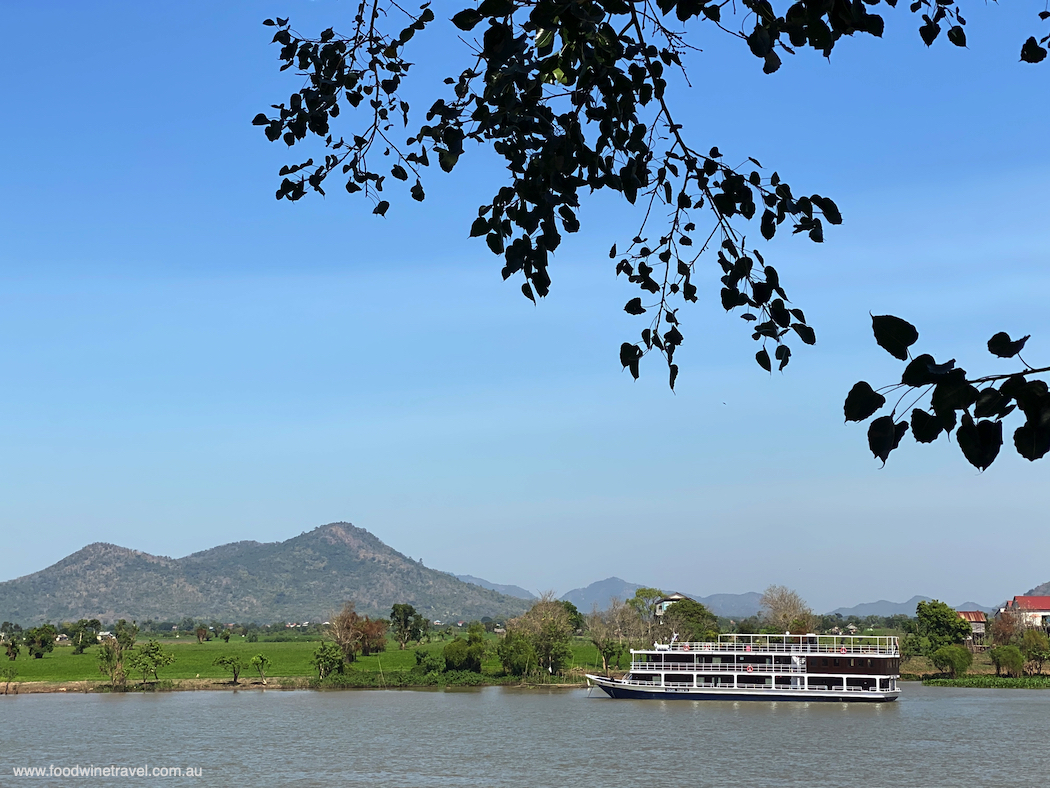
Long after you’ve forgotten the minutiae of travel – what the beds were like, the contents in a museum case, the towns you fleetingly passed – it’s the interactions you have with other people that you’re likely to remember most vividly.
In the tiny village of Kampong Chhnang in Cambodia, the other half of the Food Wine Travel duo was getting the once over from Mr Ry, a sprightly palm sugar producer with the widest smile you’ve ever seen.
Mr Ry had felt Maurie around the belly and then, with our guide translating, asked how old he was. When he discovered Maurie was of a similar vintage, he hugged and kissed him and proclaimed: “We’re brothers from different mothers.”
With the barriers down and the conversation taking a turn as we questioned him about his farm and family, the glint in Mr Ry’s eye disappeared and he offered a harrowing account of his experiences during the dreadful Khmer Rouge years.
Mr Ry was sent to a re-education camp and saw most of his family killed in one of the 20th century’s worst acts of genocide. His life was spared because of his extraordinary skill in climbing palm trees, an agricultural pursuit deemed acceptable by the regime and one that he continues to practise with remarkable dexterity.
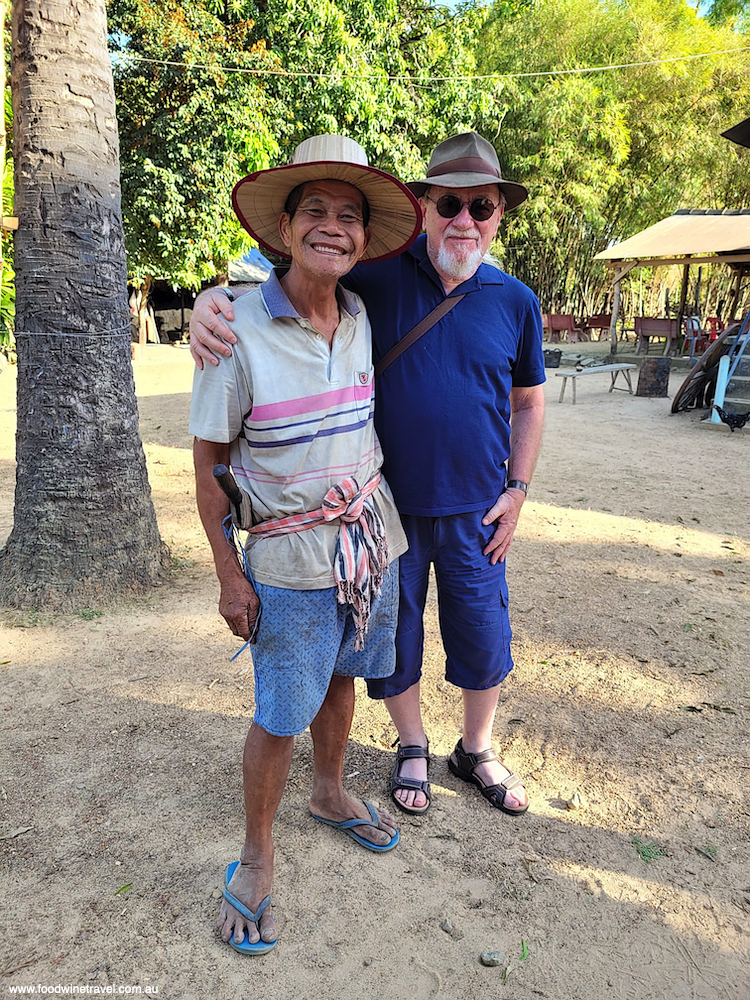
For curious folk and history nerds like us, eyewitness accounts are the crème de la crème of travel, an opportunity to gain greater insight and understanding than even the best tour guide can provide.
Being able to observe day-to-day life in Cambodia and Vietnam and to have intimate exchanges as we did with Mr Ry is one of the advantages of cruising the Mekong on a small ship like the RV Toum Tiou II.
Operated by CF Mekong River Cruises under the umbrella of CroisiEurope, Toum Tiou II was purpose-built in 2008 for cruising the Mekong, its modest size and low draft allowing it to hug the river line and access remote villages. It carries a maximum of 28 passengers in 14 cabins with panoramic windows.
Each cabin has an ensuite bathroom and two beds that can be separated or pushed together (albeit with a noticeable gap between). Eight cabins are on the lower deck and six on the main deck, the same level the restaurant is on.
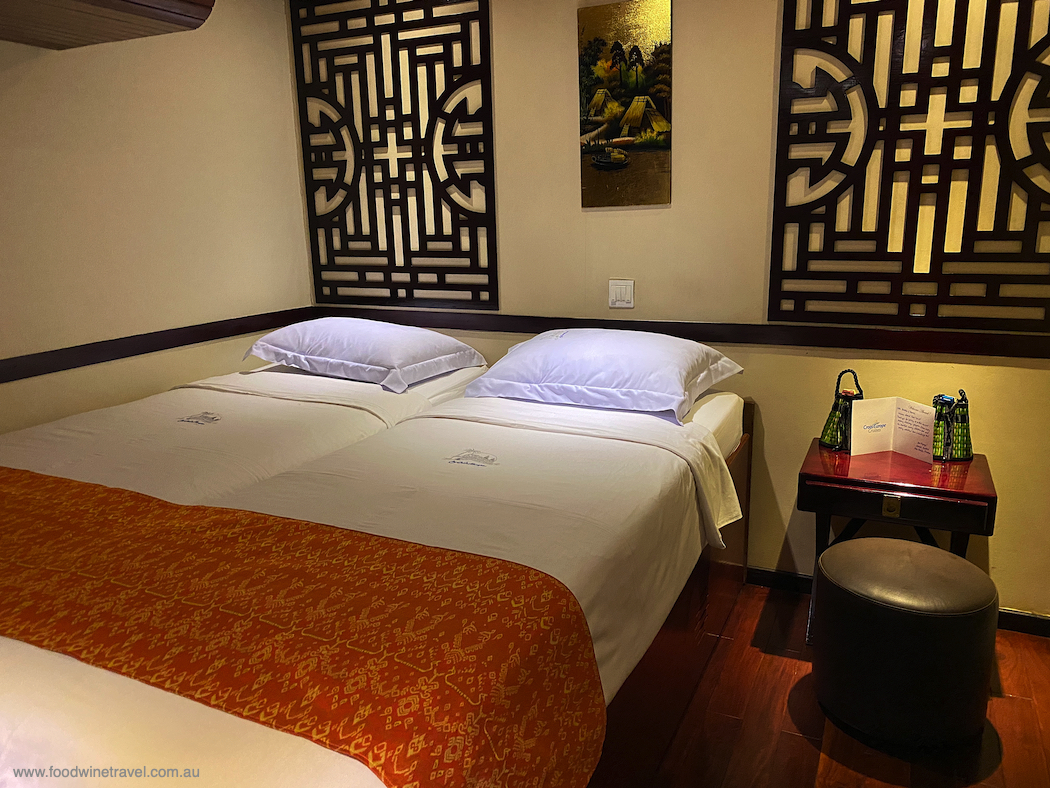
A staircase leads from here up to a sun deck and open-air lounge where we happily spent many hours watching the world go by. Note there is no lift; guests need to be reasonably agile to negotiate the winding staircase.
It should also be noted that the cabins are compact. An air-conditioning unit juts out awkwardly over one of the beds, and two people do a dance if moving about the cabin at the same time. But there’s more than enough space for everyone to relax in the lounge on the top deck.
Compared with other ships cruising the Mekong, Toum Tiou II is modest in its facilities and furnishings. Its remarkably keen prices reflect that. Yet its dark wood panelling and colonial-style design lend a charming ambience and the vessel has loads of character.
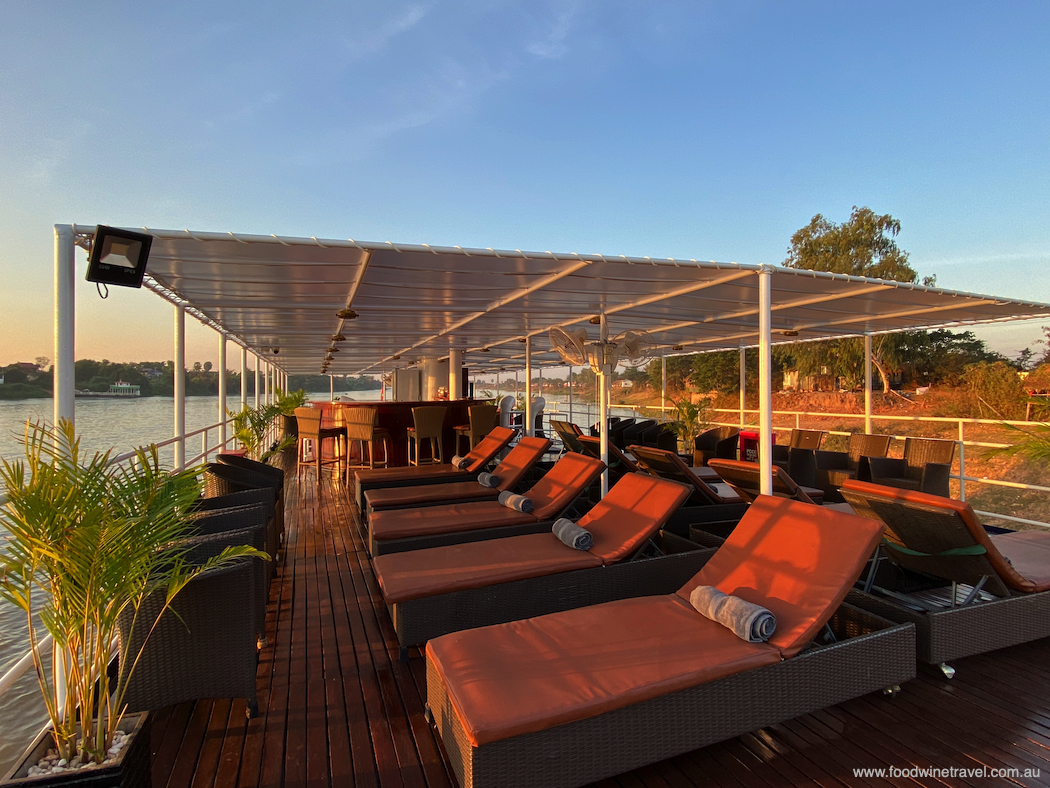
The company’s itineraries are designed to combine exploration, cultural immersion, and light activities. The New Discovery Tour we did earlier this year offered a range of activities including biking, kayaking, sampan rides and walking tours, although motorised transport was available for anyone who wanted or needed it.
For the first few days, we didn’t even cruise the Mekong. We sailed up and down the Tonle Sap River before its confluence with the Mekong at Phnom Penh. Visiting villages on the Tonle Sap was a bonus of being able to go to places the bigger ships can’t go.
Day 1: All aboard Toum Tiou II
Day 1 saw us leave Siem Reap by bus for Koah Chen Port on the Tonle Sap, a six-hour journey that offered vignettes of daily life – a woman hanging out washing over a wire fence, a young monk in saffron robes, oxen pulling carts, chickens and roosters scurrying about.
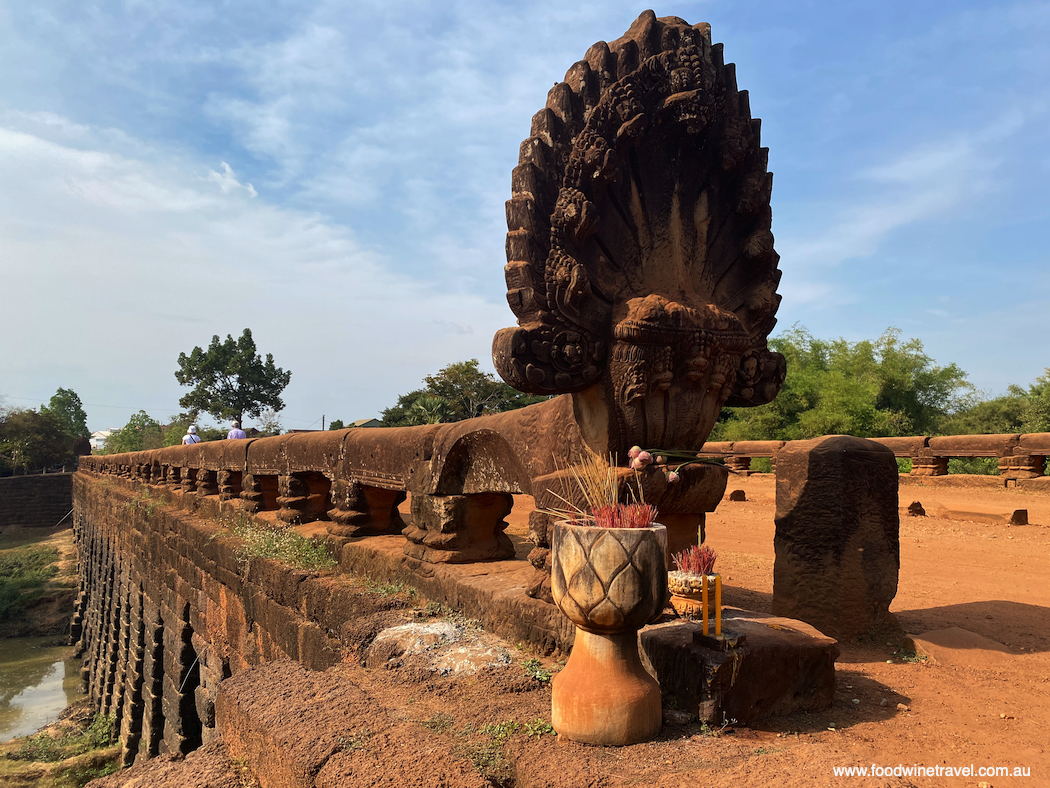
One of the two stops was a familiar sight for anyone who keeps an eye on the local currency. The Kampong Kdei bridge, also known as Spean Praptos, is a jewel of the ancient Khmer Empire. It is so architecturally, historically and culturally significant that it features on the 5,000 Riel banknote. Around a thousand years old, its 86-metre span features 21 stone arches and decorative carvings of Cambodia’s legendary Naga.
It was dark by the time we laid eyes on Toum Tiou II but the welcome was warm, the cocktails hit the spot, and we were soon seated in the restaurant for the first of many impressive meals. We were constantly amazed by the food that chef Cheu Sinat and his team turned out from their tiny kitchen, and we eagerly anticipated the lunch and dinner gong each day (no gong at breakfast in case you wanted to sleep in).
By the end of the cruise, we were best friends with Theary, who took charge of the dining room. Wearing beautiful Cambodian silk dresses and a smile that lights up a room, nothing was ever too much trouble for her. The restaurant has a small but decent selection of wine, beer, and spirits. Alcohol isn’t included in the cruise price but a tab is kept so you can pay by card or cash at the end of the trip.
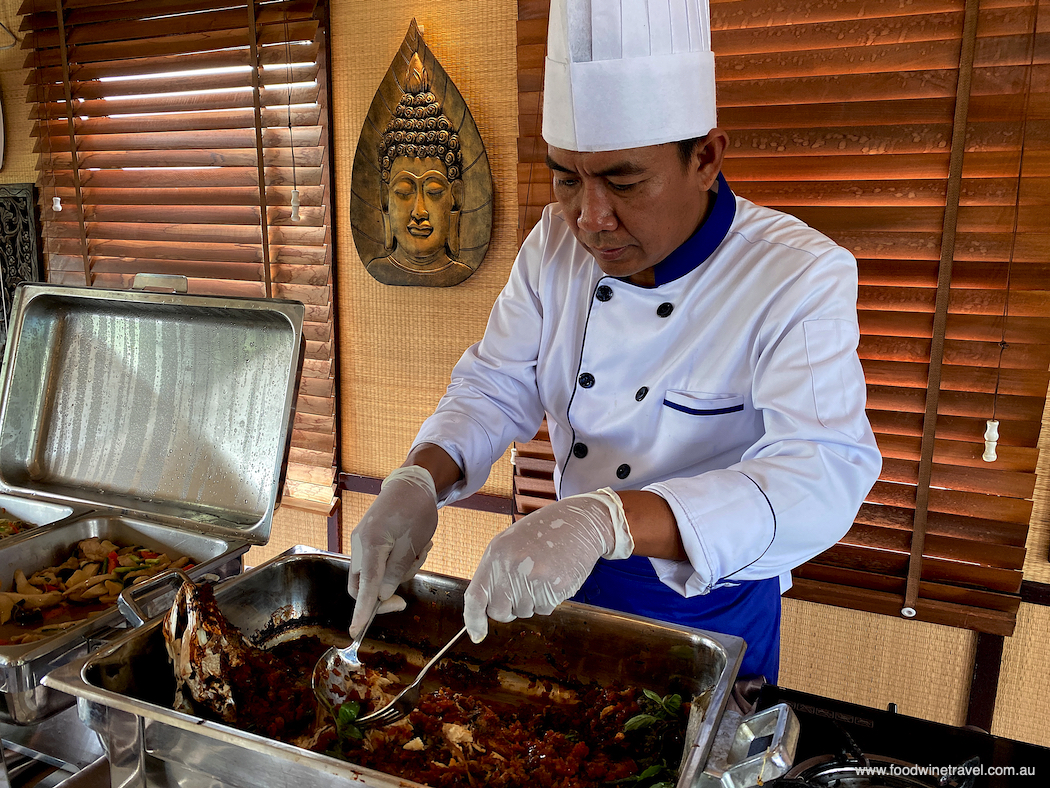
Day 2: Meeting Mr Ry in Kampong Chhnang
Day 2 saw us sailing 70 kilometres from Koah Chen to Kampong Chhnang, giving us time to settle in and get to know our fellow travellers. After lunch, we anchored near Kampong Chhnang, one of the largest fishing villages on the Tonle Sap, where a longboat took us to shore.
Kampong Chhnang translates as ‘Village Pottery’ so it’s not hard to guess that this place is famous for its earthenware. In the rural surrounds, amongst the rice paddies and palm trees, most homes are on stilts. Under many of the houses, the locals make their low-fired, unpainted, red clay pottery in the same way their ancestors have done for 1,500 years.
It’s fascinating to watch. Sophat, who demonstrated the ancient craft for us, learnt it at the age of 12 from her mother and grandmother. Starting with a cylindrical shape, the pots are whacked from the inside with a wooden spatula until they become a round shape suitable for cooking or for holding liquid. The work is done by women, usually by hand, with the women walking in circles around the stationary pots, shaping and whacking them as they go, or turning the pots in their laps while they whack away.
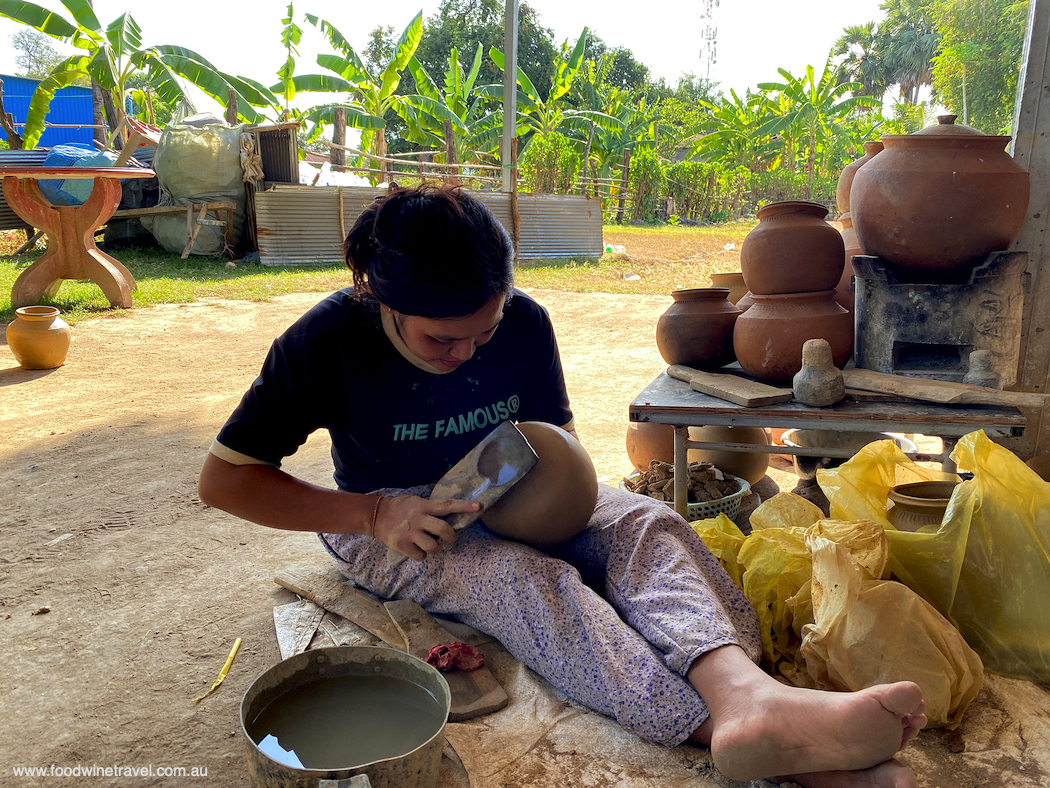
These skilled craftspeople are doing it tough, not only because of the low number of tourists post-Covid but because of competition from plastics and more durable metal products. Despite the tough times, there is no hard sell to buy (though I couldn’t resist a few small pots).
The reason these small-scale family operations have sprung up here lies in the nearby Kraing Dey Meas, or Golden Mountain, so named because when the clay is fired it takes on a gold lustre. Someone asked our guide Smiley if there was gold in it. No, he said. “If it was real gold, the Chinese would buy the whole mountain.”
Across the road from Sophat’s house, Smiley introduced us to Mr Ry, his “social uncle”. (They aren’t related but he adores him like a father.) As agile as a monkey, Mr Ry climbs 50 trees a day using a tall bamboo pole with tiny steps. At the top, a horizontal pole leads from one palm tree to another, and he traverses it as confidently as if it were a few inches off the ground.
Mr Ry uses a small implement to squeeze the palm flower, leaving it in a bamboo pot to hang in the tree overnight. When he returns the next day, the pot is filled with juice which his wife uses to make palm sugar, stirring it for hours in a huge pot over an open fire.
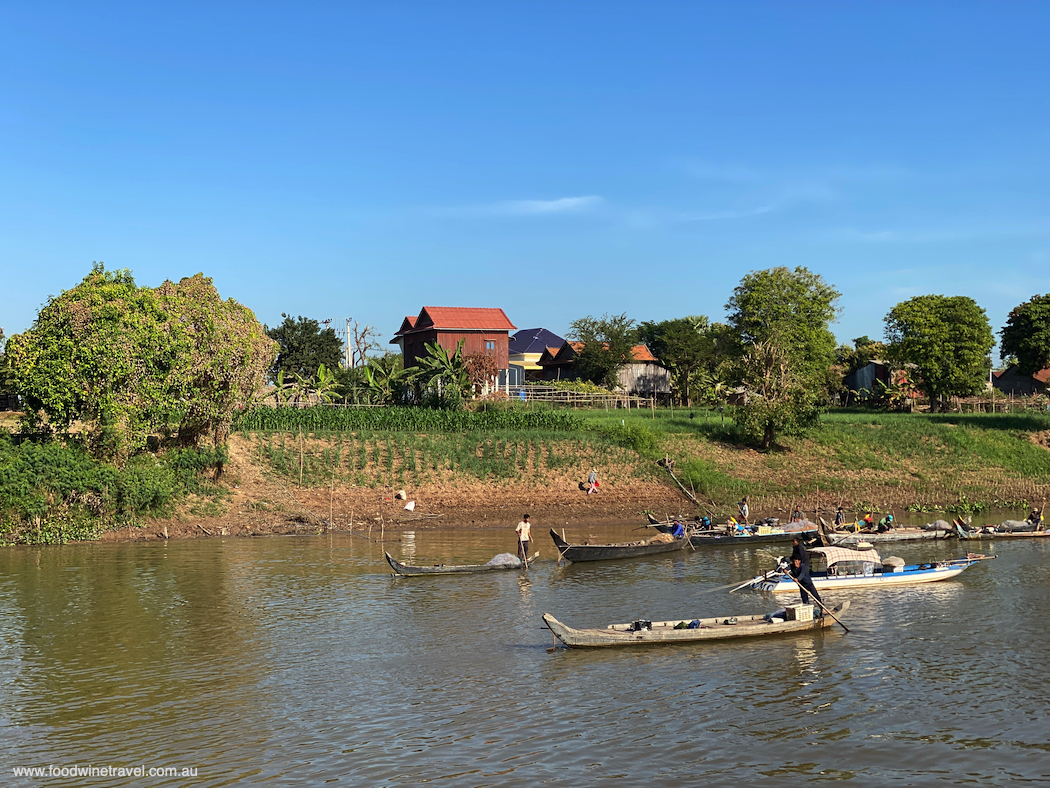
After hearing of Mr Ry’s experience at the hands of the Khmer Rouge, the mood was sombre as we returned to the ship, just in time for dinner and a magnificent sunset cruise to Kampong Tralach.
Day 3: Riding in an ox cart
Day 3 and we were up bright and early watching the village come to life: a small ferry going back and forth across the river with cars and motor scooters, a woman feeding the chooks, uniformed children riding their bikes to school. Some of the girls wore hijabs. Kampong Tralech is the main centre of the Kan Imam San community, a type of Islam practised by ethnic Chams.
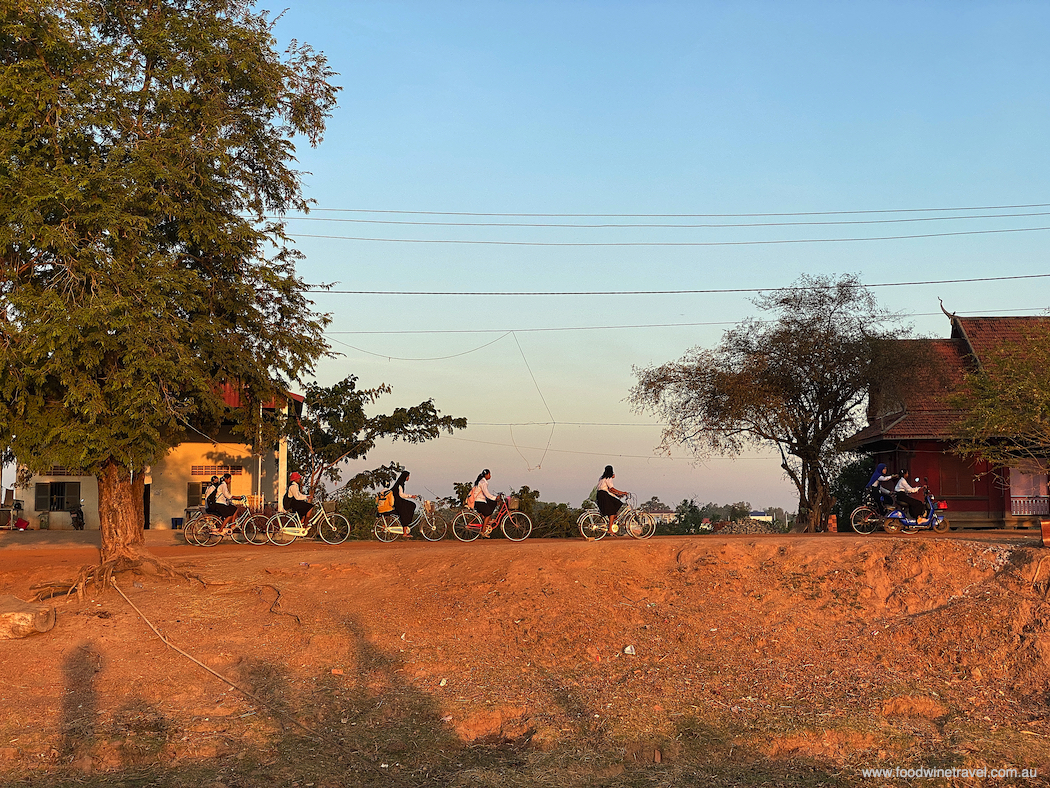
Ox carts assembled on the riverbank, ready to take us to Wat Kampong Tralach Leu, a Buddhist monastery founded in the 1600s. The five-kilometre ride on dirt roads was surprisingly gentle with one or two people per cart, seated with backs to the driver, legs outstretched, travelling at a steady pace through the village and rice paddies.
In the tranquil monastery grounds, rarely visited by tourists, young Buddhist monks in saffron robes scaled trees as young boys do and looked shyly at the interlopers. Inside the temple, we admired murals painted in the mid-1800s and listened as a monk explained through our guide how he, a father of five, turned to the monastery after his wife died.
Having received the monk’s blessing with a red thread tied around our wrists, we travelled by tuk tuk back to the village, where two nine- and 10-year-old schoolgirls were keen to practise their English. “How many brothers and sisters do you have?” they asked. “Do you have any pets?” “What time do you brush your teeth and go to bed?” The questions kept coming with each girl prompting the other.
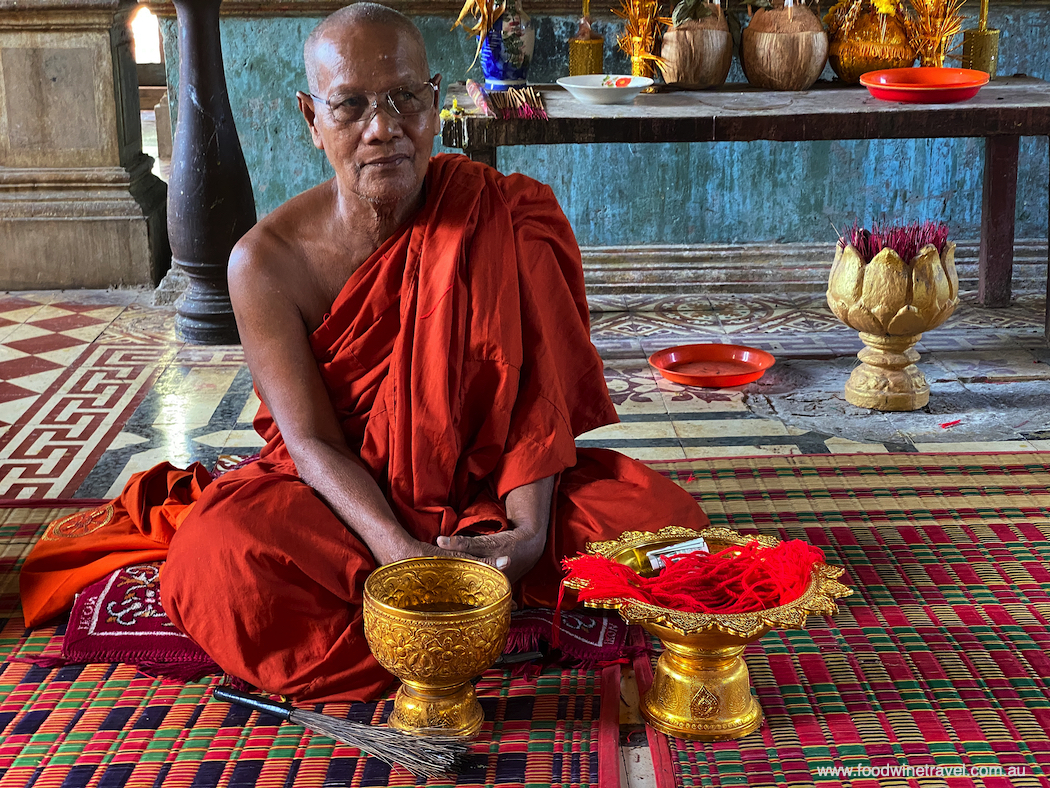
After lunch on board, the ship sailed 10 kilometres downstream to Oudong, the capital of Cambodia from the early 17th century until 1866 when the royal court moved to Phnom Penh. Today, Oudong is a pilgrimage site and a popular weekend destination for Phnom Penh residents, being just 33 kilometres away.
The region is working towards UNESCO World Heritage listing, such is the significance of the temples and stupas on Oudong’s hills, where Buddha relics and the remains of several Cambodian kings are held. The view from the top is said to be impressive but we ran out of time to do the climb, having had way too much fun exploring the local market, which was busy and colourful with both fresh food and cooked dishes, including many that were unfamiliar.
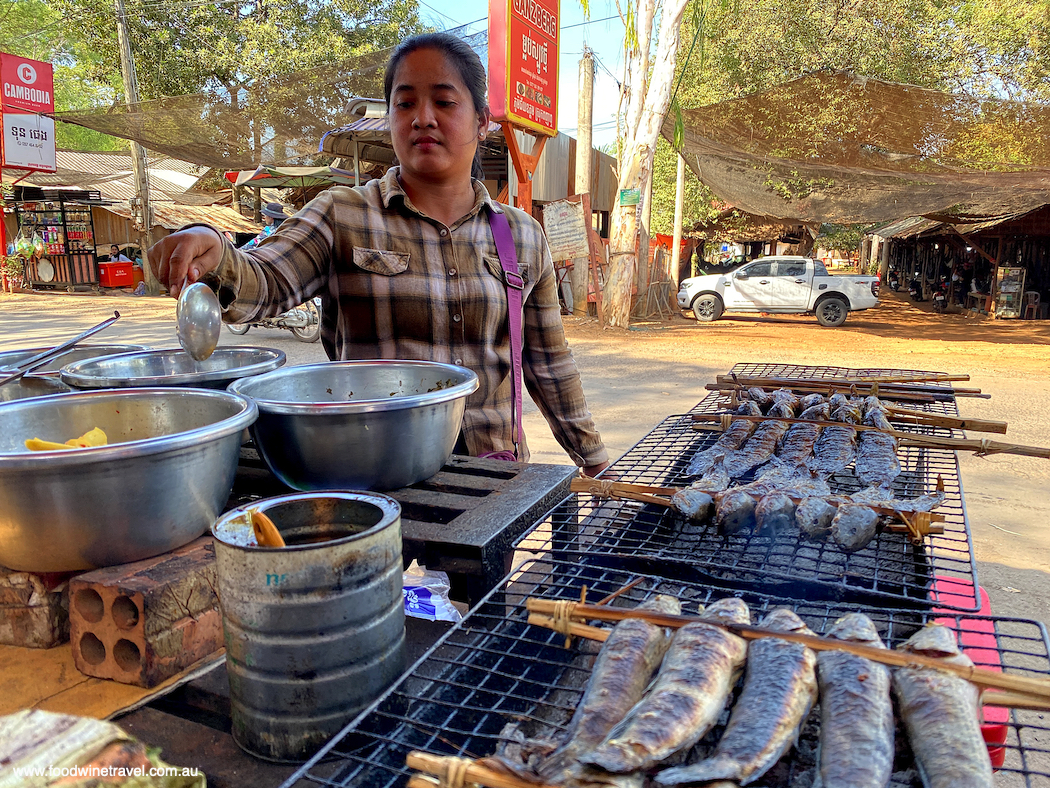
We did get to walk around the Vipassana Dhura Buddhist Meditation Center with its stunning golden pagoda where around 100 monks meditate and pray. “We don’t have nursing homes in Cambodia, we have monasteries,” said Smiley, who introduced us to a nun who came here after raising her family of 10 children and 57 grandchildren.
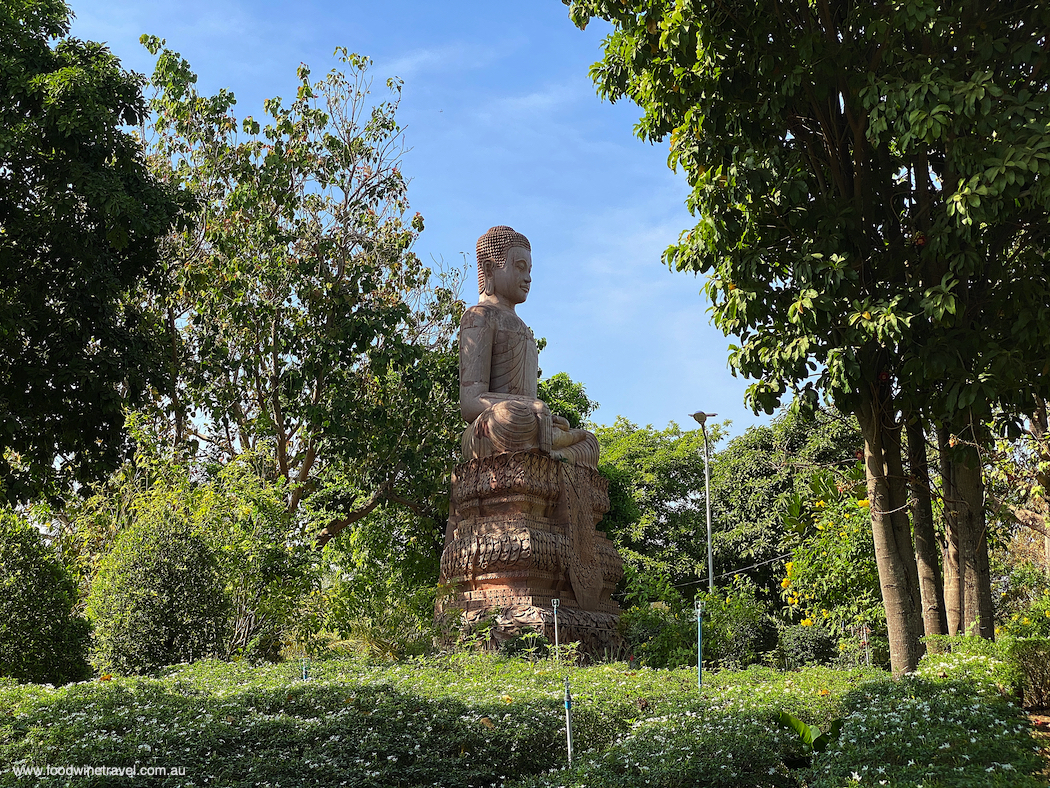
Back on board, we sailed into the mighty Mekong at Phnom Penh, smiling at the irony of a fisherman taking a photo of us from his boat. Against a backdrop of city lights, we were treated to a wonderful dance performance by members of a national cultural association, including the legendary apsara dance, recognisable in the motifs on Angkor temples.
Day 4: Getting to know Phnom Penh
Day 4 saw us exploring the Cambodian capital, Phnom Penh, once described as the Pearl of Asia and still a treasure trove despite the horrors of the Pol Pot era. Having already been to the Killing Fields and the Tuol Sleng Genocide Museum on an earlier visit, we toured the sprawling Royal Palace complex, the impressive National Museum, the domed Art Deco style Central Market, beautiful colonial buildings in the French Quarter, and Wat Phnom, the pagoda that gave the city its name.
Returning on board for dinner, we farewelled Smiley and began the 100-kilometre cruise to the border with Vietnam.
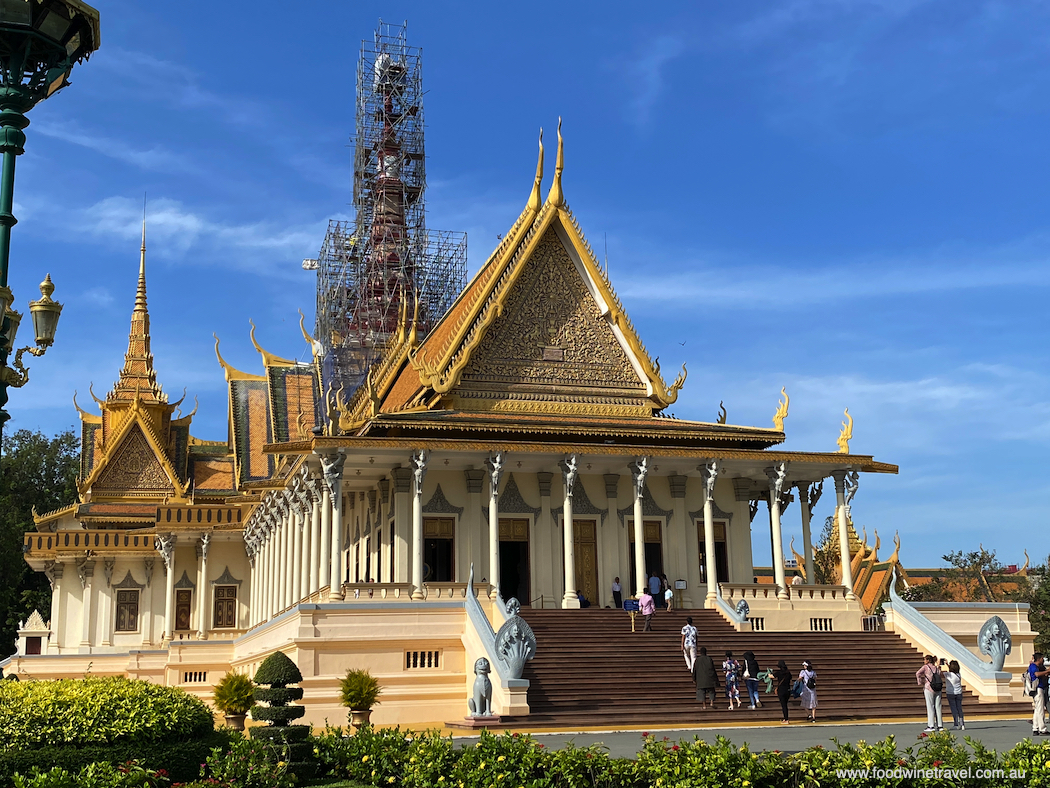
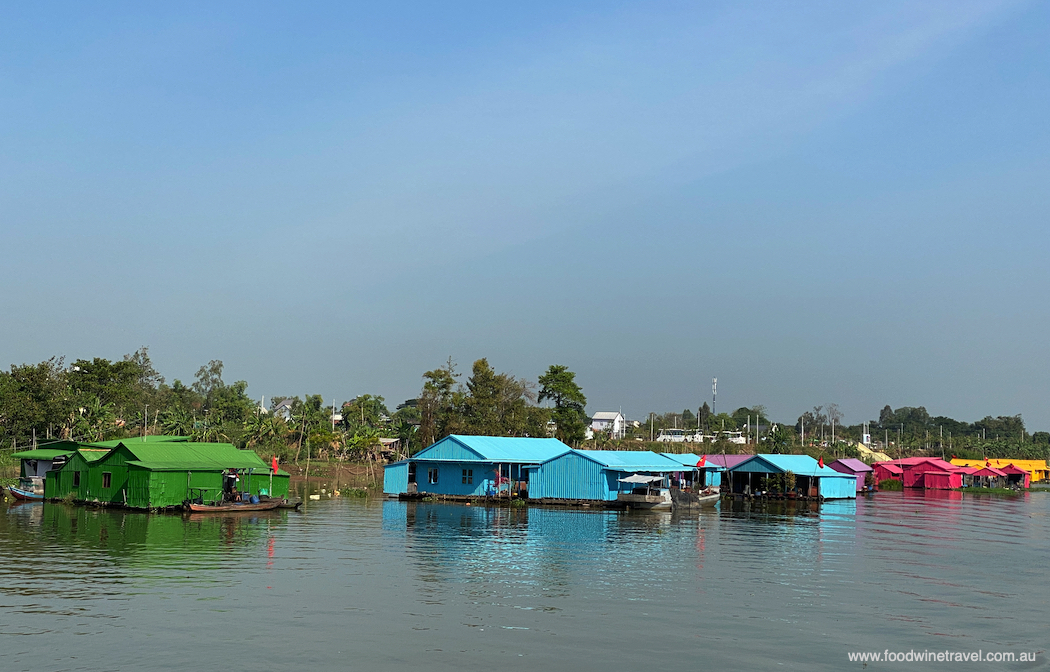
Day 5: A little bit of Oz in Vietnam
On Day 5, the ship arrived early at the Vinh Xuong border crossing and was cleared for entry before we were awake. From here, it was a 32-kilometre journey to Chau Doc, a neat, prosperous city that has developed around fishing and fish farming. Brightly coloured houses float on the river, the different colours denoting different family groups.
Now with a super enthusiastic Vietnamese guide, Steven, who is 23 and wise beyond his years, the group set off for a morning cable car ride to a pagoda on Sam Mountain. After lunch on board the ship, an afternoon excursion to Tra Su Forest saw us sailing on a motorised boat and row-boat through a forest of melaleuca.
Wait, aren’t these trees from the Land Down Under? Well, yes, but they thrive in southern Vietnam and they have become an important conservation tool for preserving the wetland ecosystem in the Mekong Delta. Plants, animals, birds and aquatic species abound in this peaceful forest which was planted 40 years ago and opened to tourists in 2006.
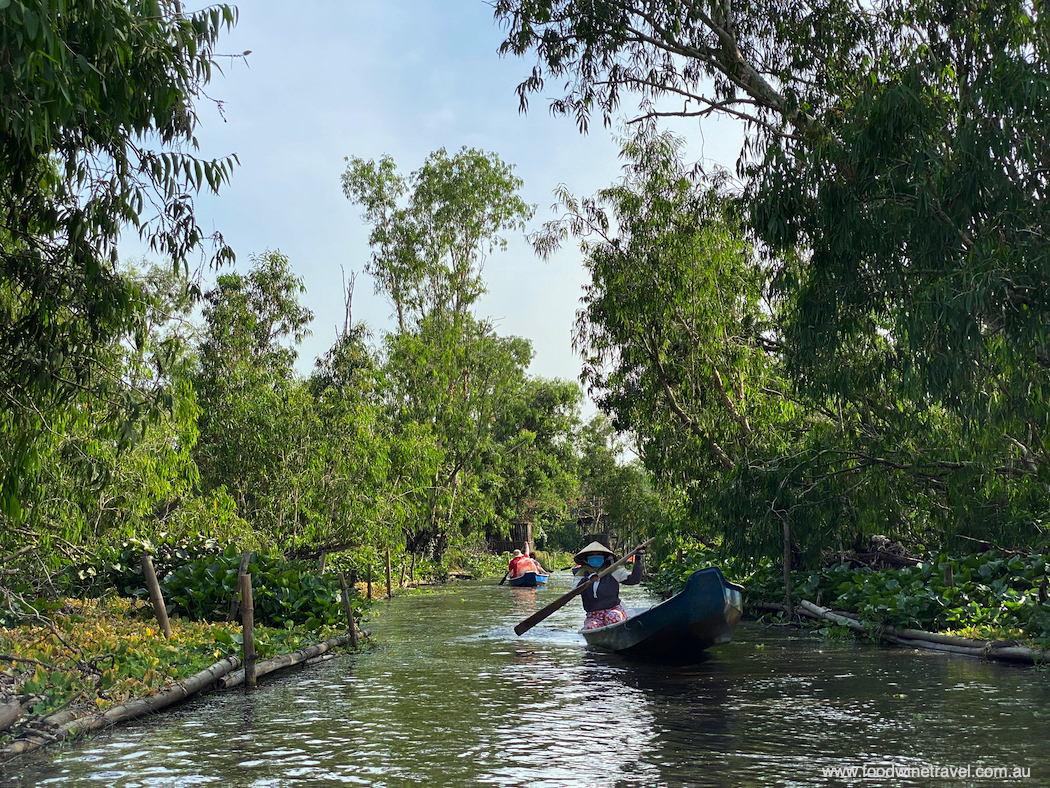
The pungent smell of fish being fed at the fish farms assailed us as we arrived back at the ship to begin the 100-kilometre cruise to Sa Dec. Soon after we anchored in the river around 11pm, a long boat pulled alongside the Toum Tiou II and dropped off cartons of mangoes and papaya. At the same time, it took away a small fridge – a new one had been brought on board earlier in the day in Chau Doc. Door-to-door service at its finest.
Day 6: At home with The Lover
Day 6 began with another great market tour, this time in Sa Dec, a provincial city famous for its flower nurseries and immortalized in Jean-Jacques Annaud’s film L’Amant (The Lover). The market lines the riverbank and has an amazing array of food, from fermented cabbage, lotus, quail eggs and cumquats, to dragon beans, eel, straw mushrooms, long green beans and so much more.
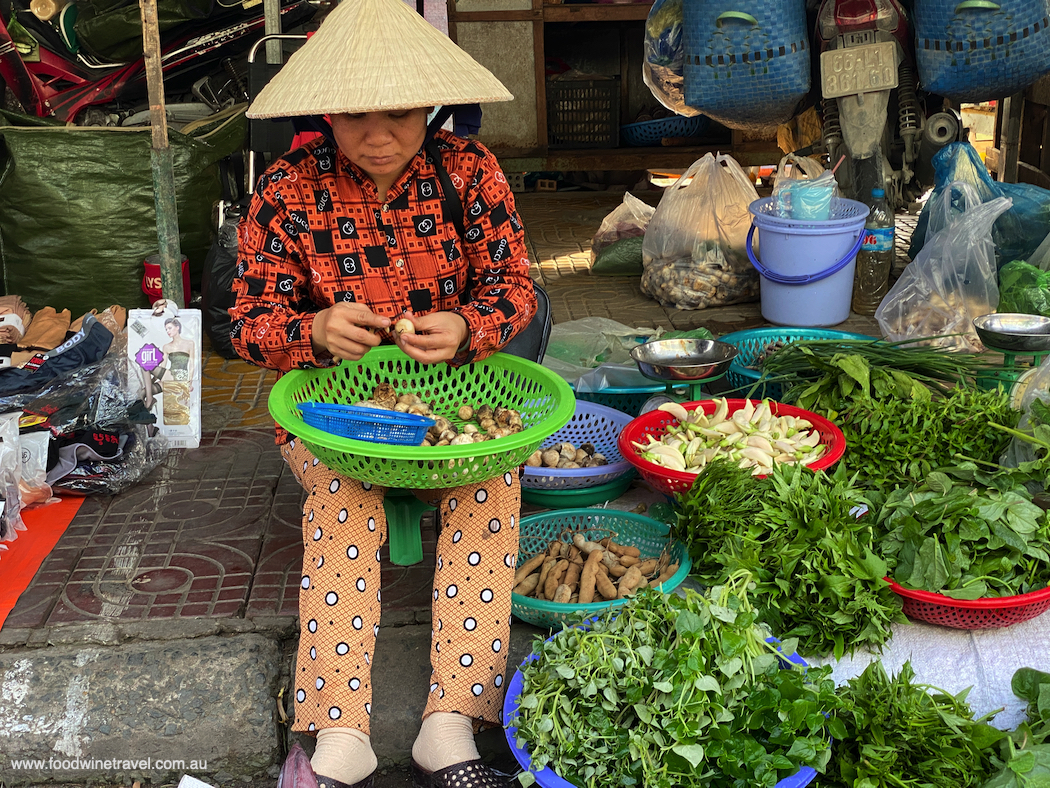
A highlight in Sa Dec was visiting the house of the wealthy Chinese family whose 27-year-old son, Huynh Thuy Le, was The Lover in the novel by French writer Marguerite Duras that the film was based on. A true story, the affair began when Duras was 15, which possibly accounts for the difficulty I had in finding a copy of the book in Vietnam. (I’ve since tracked it down in my local library.)
In the book, Duras describes the ferry journey on the Mekong between Sa Dec and Vinh Long: “… My mother sometimes tells me that never in my whole life shall I ever again see rivers as beautiful and big and wild as these, the Mekong and its tributaries going down to the sea, the great regions of water soon to disappear into the caves of ocean.”
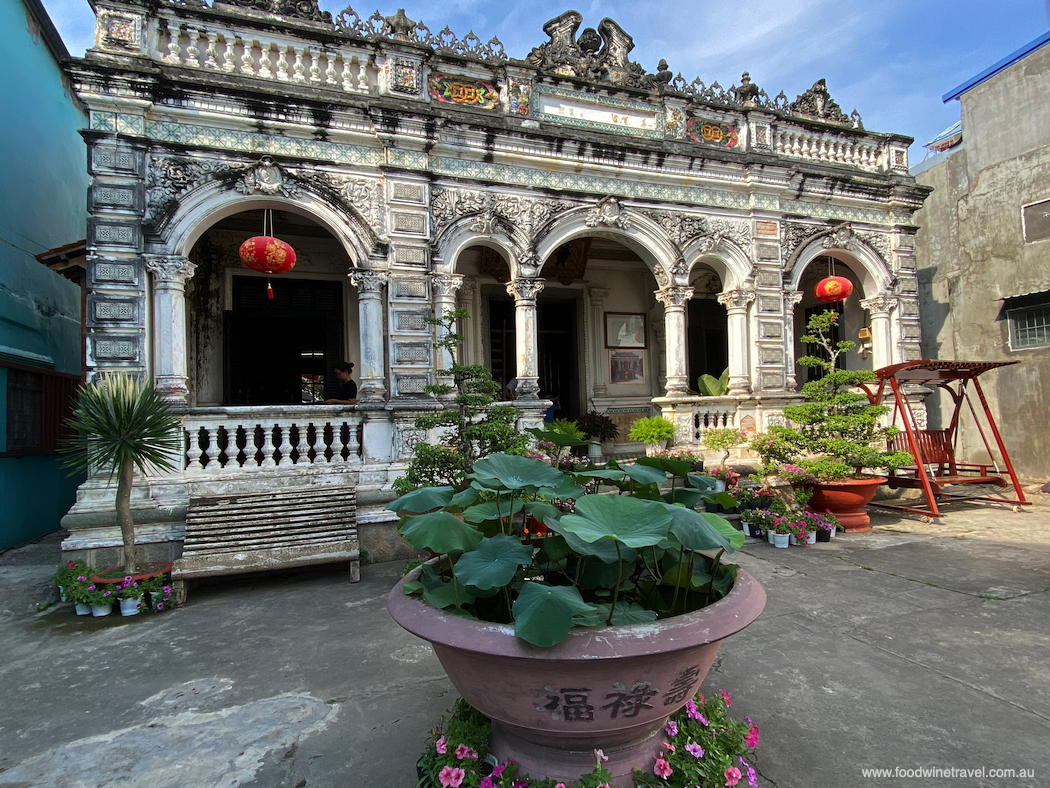
The river was still one to leave an impression as we sailed the 20 kilometres to Vinh Long and a further 16 kilometres to Cai Be, where we anchored and took an afternoon excursion by local boat to a workshop selling food and handcrafts. I wouldn’t normally be excited about a shop visit but Thanh Tri was a little different for a few reasons – firstly because there wasn’t any hard sell but more importantly because you could watch an array of different food products being made.
The Mekong Delta is the ‘rice bowl’ of Vietnam and one of its most popular snacks is crispy puffed rice, made quite spectacularly in a huge wok over an open fire before being combined with ingredients such as coconut milk, palm sugar, pandan, ginger, peanuts and even onion. We also saw rice paper being made, and delicious sweets made from palm sugar and coconut milk. I couldn’t resist the cocoa-flavoured sweets.
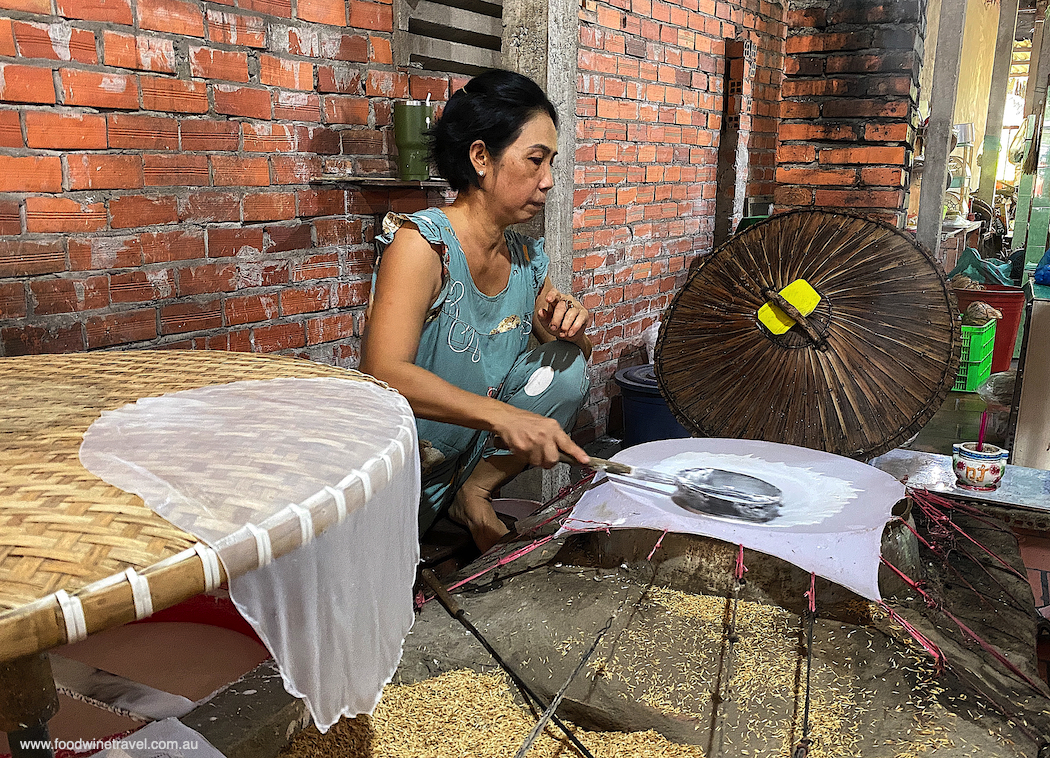
Of less appeal was the cooking class and late lunch at a riverside eco resort as it was the sort of class you have when you’re not having a class, ie. very basic ingredients, already prepared so all you had to do was roll the spring rolls and swirl the ban xeo (crispy pancake) batter. I’ve done way more interesting Vietnamese cooking classes in Australia.
There was an opportunity to go bike riding or kayaking before returning to the ship for a 40-kilometre evening sail to My Tho, where we anchored in the river with a view of the city night lights.
Day 7: A privilege to sail the canal
Day 7 required an early start with lots on the agenda – visiting the islands around My Tho, navigating the busy Chao Gao canal, and arriving at our destination, Ho Chi Minh City.
Four of the islands are named after sacred animals — Dragon, Unicorn, Phoenix and Turtle – and we boarded a local boat to visit the biggest, Unicorn (otherwise known as Thoi Son). With a population of 6,000, it’s a relaxed, laidback place that largely depends on selling tropical fruits, honey, and associated products to visitors.
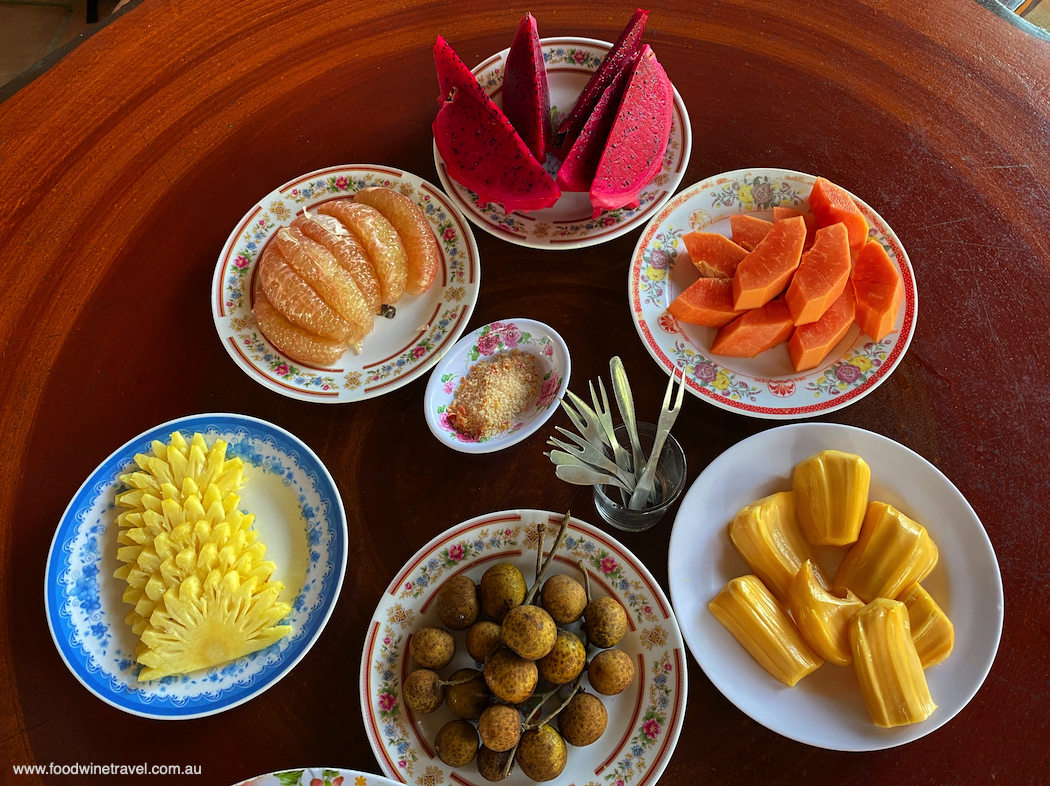
Many visitors are day-trippers from Ho Chi Minh City, who appeared to enjoy as much as we enjoyed being entertained by musicians and singers performing folk songs that originated during the French Indochina War. In 2013, these haunting melodies were inscribed on the UNESCO World Heritage list of intangible assets.
A sampan ride, a visit to a honey producer, and the opportunity to drape a 10kg python around our necks (Maurie was the only one who took up the offer) followed, and by mid-morning we were back on Toum Tiou II ready for the final leg of our cruise, a 120-kilometre journey to Ho Chi Minh City.
There was a sense of doing something special as we cruised the Chao Gao canal. This busy waterway cuts off a huge amount of travel time to Ho Chi Minh City, and CF Mekong / CroisiEurope is the only cruise line that offers it.
Vastly different from the waterways upstream, it is much like being on a busy highway. It was thrilling to watch our little ship overtaking much larger vessels shifting gravel and other commodities. We wondered about the dog walking blithely on the roof of one of the boats.
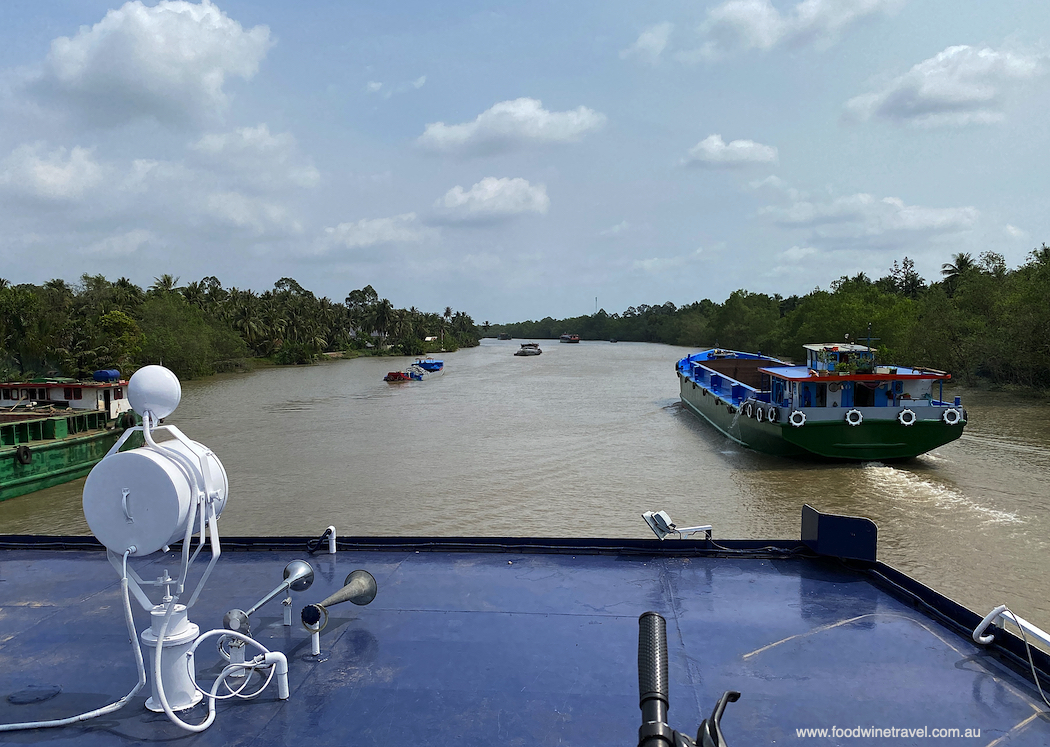
In the afternoon, our guide Steven did a great presentation on Vietnam, its cultural life, traditions, and language … pho must be pronounced “faaarr” otherwise they’ll think you’re talking about prostitution … Nguyen, the most common Vietnamese surname, is pronounced “Win” … at seven letters, nghiêng (‘to lean’) is the longest Vietnamese word.
Ho Chi Minh City put on quite a show for our arrival, with dusk giving way to illuminated buildings and a skyline that is practically unrecognisable from the one I first saw two decades ago. Some in our group did a Vespa tour in the evening (an optional extra), riding pillion as they explored the city’s street food.
Day 8: People-watching in Saigon
Ho Chi Minh City (or Saigon as the locals still call it) is a city I never tire of as it’s such a great city for people-watching. And we did plenty of that during a city tour on Day 8 which started with a visit to Independence Palace, where Saigon fell to Communist forces on 30 April 1975, bringing an end to decades of war.
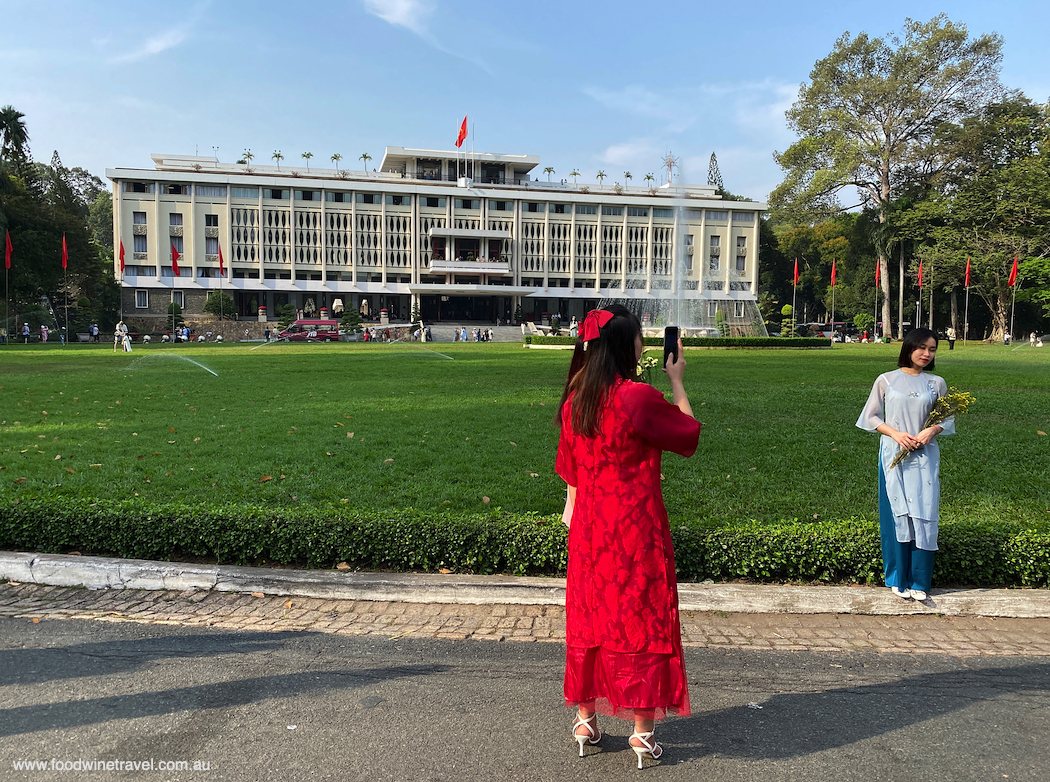
As Maurie and I had already visited Independence Palace, we strolled in the park opposite, where President Ho Chi Minh read the Declaration of Independence. A popular hang-out for the young and beautiful, the park is known to locals as Cà Phê Bệt, literally “coffee on the flat ground”. Street vendors sell Vietnamese iced coffee, tapioca ‘pearl tea’ and snacks; everyone brings rugs to sit on, and some bring their pets – we even saw a cat on a lead.
Re-joining the group, we strolled from the Notre Dame Cathedral, built during the French colonial era and currently under wraps while being renovated, to another iconic colonial building, Saigon Central Post Office. Our walking tour continued past the Opera House and the very ornate People’s Committee Building, before returning to the ship for lunch.
An afternoon tour took us to the War Remnants Museum and the Ben Thanh Market, and then it was back to the ship for sunset cocktails and a farewell dinner.
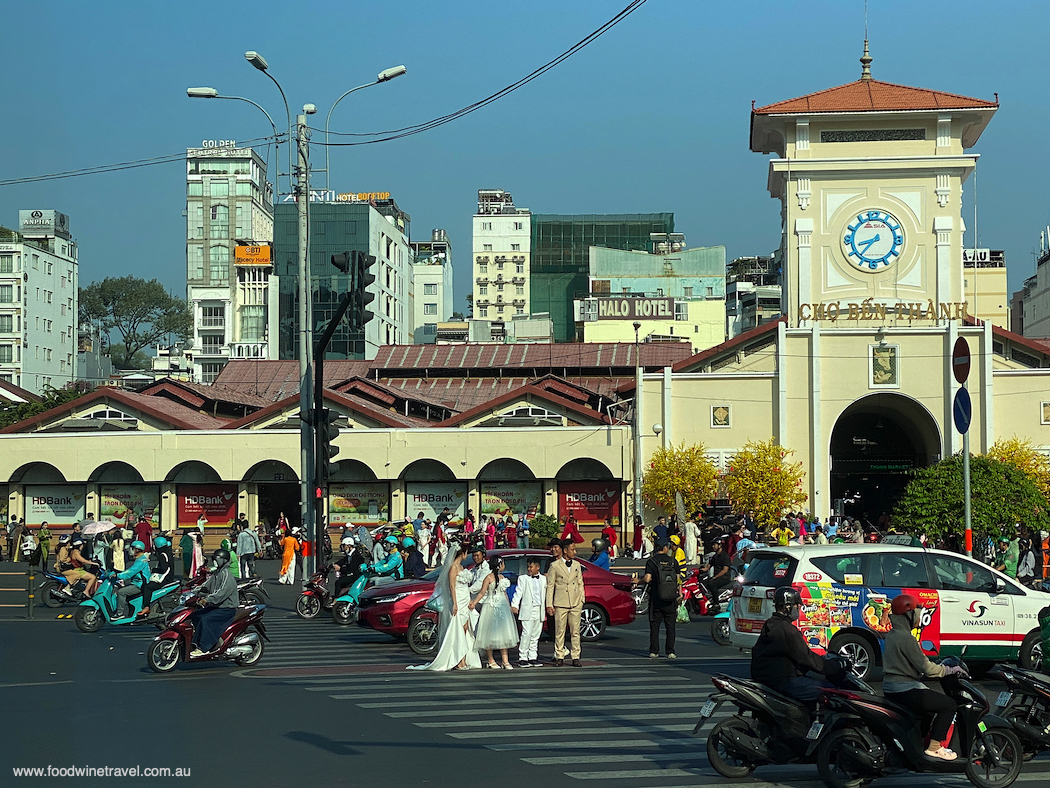
Day 9: Saying our goodbyes
Yet it wasn’t quite over – we still had another tour on Day 9, this time to Cholon, Saigon’s Chinatown, where we visited an ancient pagoda, strolled amongst herbal medicine shops and were blown away by the organized chaos of the sprawling Binh Tay Market.
The effusive Steven was still regaling us with stories. “At 14 or 17 (we) learn cooking, electrician or Microsoft skills. If your class has more women, it’s cooking,” he said. “I like cooking. It’s the only class where I can tell my teacher ‘my dog ate my homework’ and it makes sense.”
I’m sure plenty of guests before us had heard that one but you can never tire of a good story, just like you can never tire of Vietnam and Cambodia.
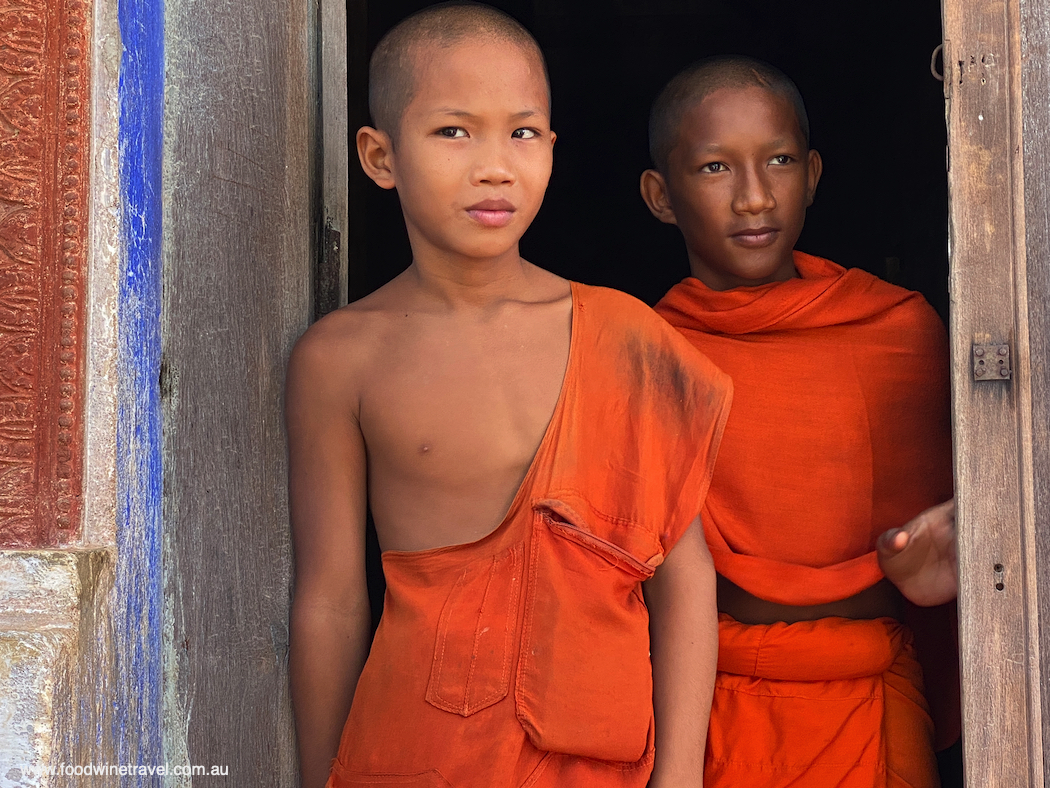
After a wonderful buffet lunch at Saigon’s Liberty Central Riverside hotel, we bid adieu to our travelling companions and headed to a café to introduce a couple of our new friends to the delights of Vietnamese egg coffee.
Looking back on the whole experience, it was great doing the cruise in the direction we did, because sailing into Saigon has a real sense of arrival, especially at night when the skyscrapers are illuminated. Larger cruise ships dock one to two hours’ drive from downtown Saigon. That we could alight in the heart of the city was another bonus of cruising on a small ship like Toum Tiou II.
For more information about CF Mekong River Cruises’ New Discovery Program, visit www.cfmekong.com
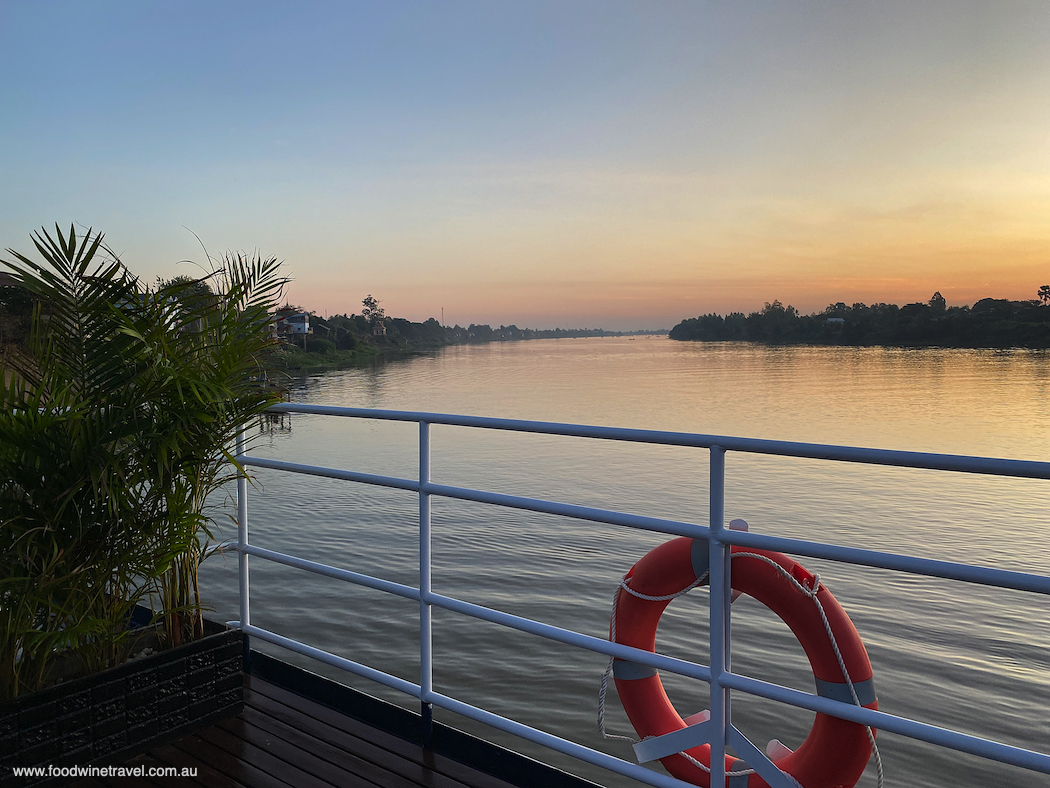
With thanks to CF Mekong River Cruises and CroisiEurope for hosting us on Toum Tiou II. We paid for our flights to Vietnam and bus travel to Siem Reap.
Photos © Christine Salins and Maurie O’Connor / Food Wine Travel.

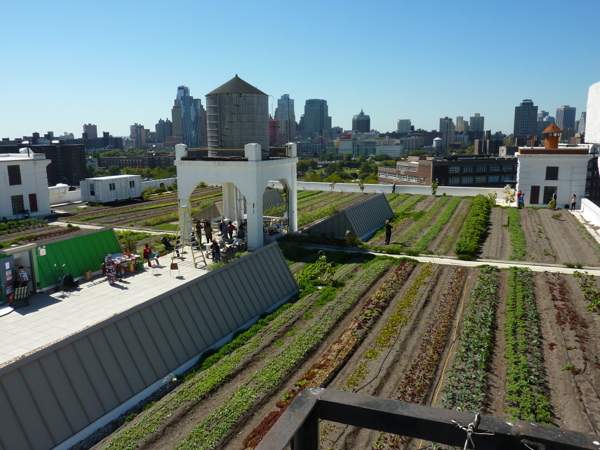
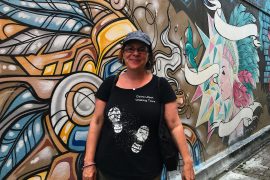
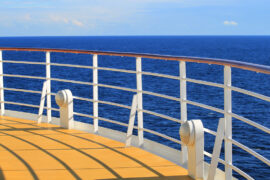
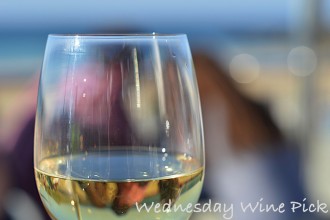
This really sounds like a wonderful cruise, particularly on such a small boat. I have a horror of large boats with flocks of people! The onshore experiences you had were obviously very special!
Certainly not flocks of people on this one 🙂